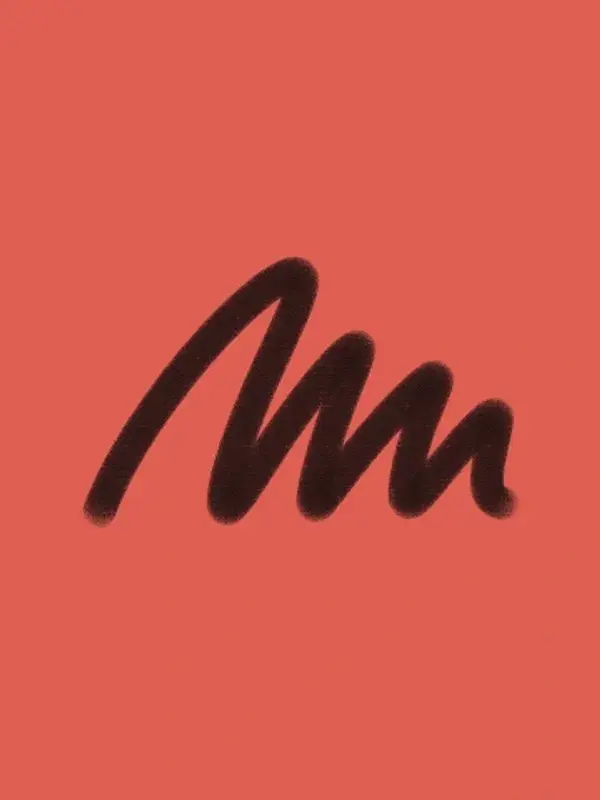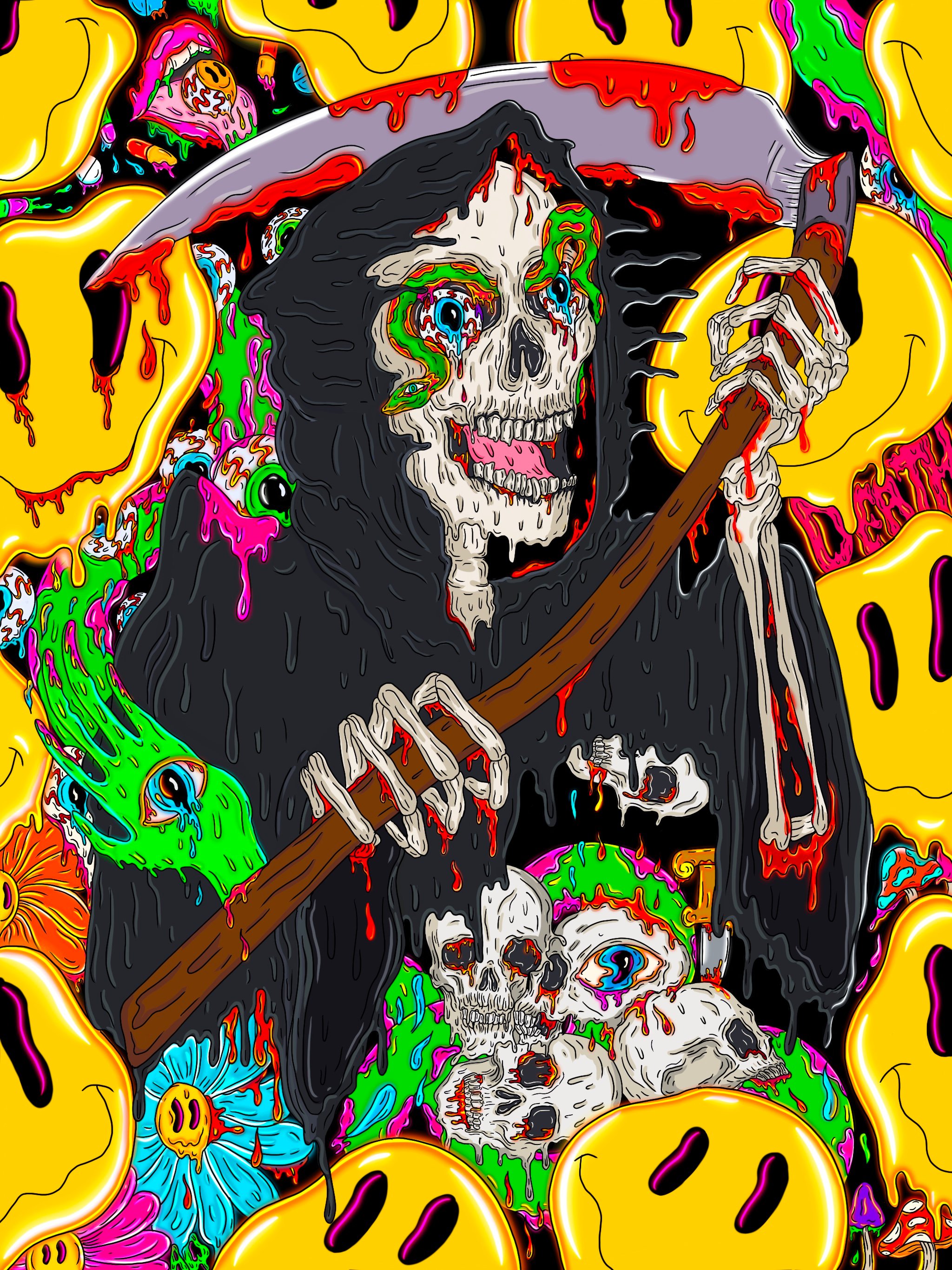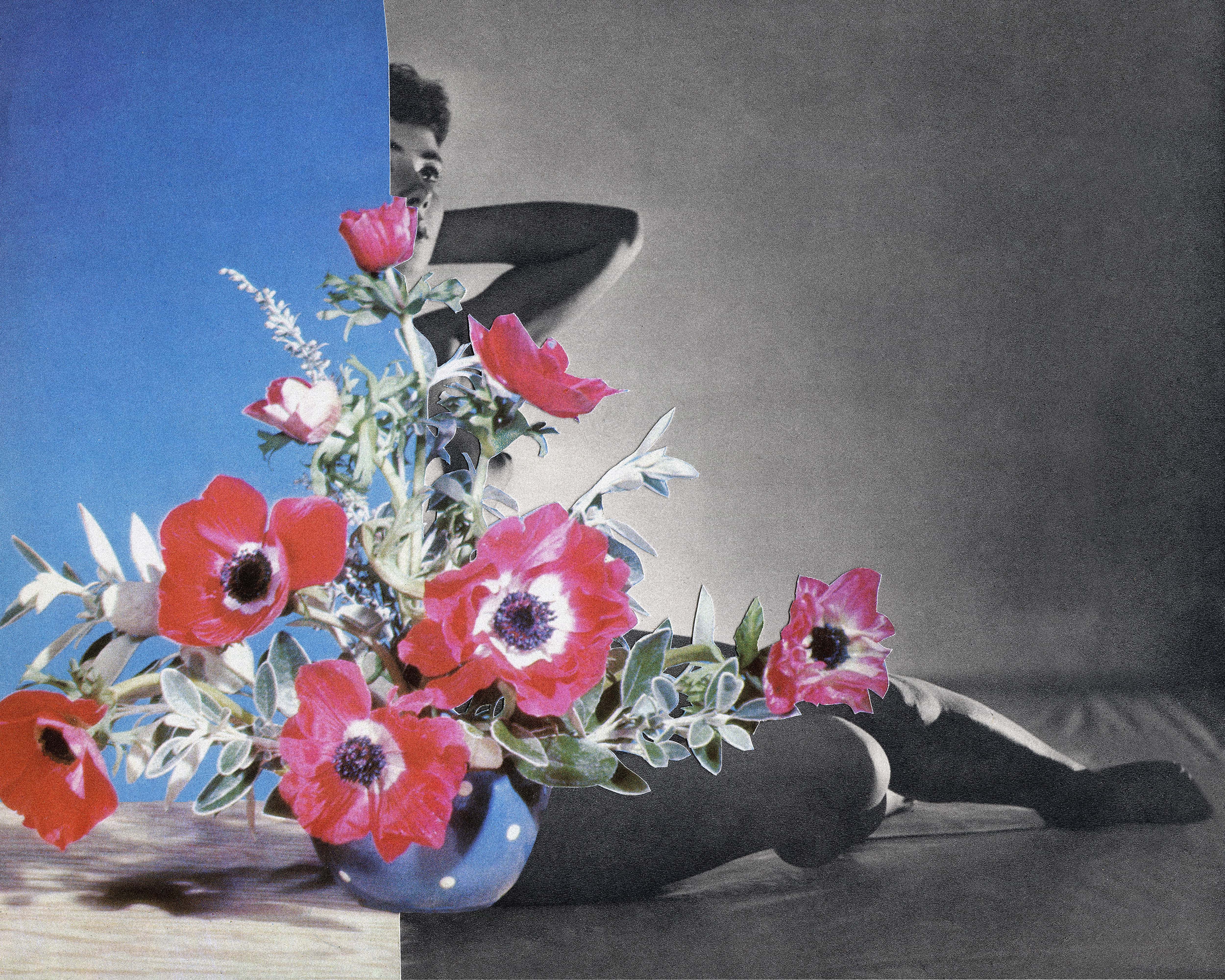Mind Mechanic
About the Artist:
As a Psychiatrist with a rich background in both psychiatry and neurology, Mind Mechanic is an artist whose oeuvre of work delves into the intricate workings of the human psyche, exploring how our thoughts and emotions shape our perception of the world. Through a rich blend of research, color psychology, and elements of abstraction and surrealism, Mind Mechanic’s art seeks to capture the intangible aspects of the mind and its relationship to the self. By looking to challenge and expand the traditional notions of humanity, Mind Mechanic investigates how artificial intelligence can enhance and deepen our understanding of the world. For Mind Mechanic, the pursuit of insight and learning through art is central to our subconscious.
The creation of the genre chromatic allegory for Mind Mechanic is a delicate balance of creativity and color theory. Each element, from the composition to the choice of colors, is meticulously crafted to imbue the artwork with layers of symbolism and references, inviting viewers to embark on a journey of interpretation and introspection.
Drawing inspiration from vast sources such as literature, philosophy, clinical psychology and cultural references, Mind Mechanic synthesizes these influences into a cohesive narrative that speaks to universal truths and timeless themes. The careful selection of colors enhances the emotional impact and reinforces the message, with each hue, saturation, and tone contributing to the overarching narrative.
Ultimately, the power of Mind Mechanic's art lies in its ability to transcend the confines of computational processes, sparking contemplation and dialogue about the human condition and the mysteries of existence. Through its rich symbolism, layered narratives, and thoughtful use of color, Mind Mechanic invites viewers to explore the complexities of life, offering glimpses into the profound truths that lie beneath the surface.
Mind Mechanic’s work has been exhibited in major cities including New York, Paris, Istanbul, and Kuala Lumpur, among others.
About the featured work:
Alter Ego, 2024
This artwork is now available for sale on SuperRare with a reserve price of 2.5 ETH. This digital work offers any any winning bid of 2.5 ETH and above a 1/1 custom hand-built timepiece with the featured artwork adorned on the dial. Any bids of 3 ETH or over will receive both the custom hand-built watch and the custom museum-grade framed artwork (30x60 inches).
Alternatively, there is also a buy-now option available exclusively in $RARE, with a price point of 100,000 $RARE, if interested in this this purchasing option the collector will be eligible to receive both the custom hand-built timepiece and the custom museum-grade framed artwork (30x60 inches).
The Interview:
Paloma: Your work merges psychiatry, neurology, and art in unique ways. Can you explain how your background in these fields influences your creative process?
Mind Mechanic: My background in psychiatry and neurology profoundly influences my creative process, granting me a deeper understanding of the brain’s mechanisms and the complexity of the human mind. This expertise and particular area of focus allows me to explore themes such as human consciousness, identity, and emotional states with a robust scientific foundation. In my work, I often draw upon clinical experiences and neurological theories, using them to shape the symbolism and structure of my art. This approach ensures that each piece is not only visually compelling but also rich in psychological and neurobiological insight. It is the duality of my psychology working and educational background that supplements and further allows me to unearth these rich dichotomies to understand how we as the viewers and the artist might experience as well as understand a visual work of art.
Paloma: You’ve coined the term "chromatic allegory" for your genre of art. Could you elaborate on what this means and how you use color theory to craft your pieces?
Mind Mechanic: “Chromatic allegory” refers to the use of color as a primary tool for storytelling and symbolic representation within my art. By meticulously selecting and combining colors, I create layers of meaning that convey emotional and psychological narratives. Color theory plays a crucial role in this process, as each hue, saturation, and tone is chosen to evoke specific responses, guiding the viewer through the intended journey within each work. For instance, blues might symbolize introspection and calm, while reds can signify passion or conflict. Each color choice contributes to the overall narrative and thematic depth of the piece. It is through this intentional selection of color that my work strives to emulate and create density behind each work drawing parallels again to how each color choice is deeply informed by how we perceive and understand color, contributing to the overall narrative and thematic depth of the piece.
For example, my artwork titled The Fine Line which is now within the collection of @Batsoupyum. This particular artwork depicts the very fine line between belief and delusion, hope and denial, confidence and arrogance.
In this artwork we see the central figure, a woman facing the wall, which can represent the individual grappling with these conflicting emotions and beliefs. Her stance serves a symbolic purpose- a withdrawal from external influences, focusing instead on her inner turmoil. Her attire—a yellow long-sleeved shirt and red pants—is too intentional. The yellow symbolizes hope and red represents passion and intensity, underscoring the vibrancy of human emotions. The background, a shade of green reminiscent of smooth moss, symbolizes the naïveté in her current state.
The most striking element of the artwork is the pink rope tied around the woman's neck, being pulled at both ends. This symbolizes the tug-of-war between opposing forces, each vying for control over both her thoughts and actions. The color pink, often associated with compassion and love, adds layers of complexity to the piece, suggesting a struggle rooted in deeply ingrained emotions.The act of being pulled in different directions reflects the internal conflict experienced when one finds themselves standing on the fine line between hope and denial, belief and delusion, confidence and arrogance. It invites viewers to contemplate their own experiences of navigating these intricate emotional landscapes and encourages introspection into the complexities of the human psyche.
Through works like "The Fine Line," I strive to capture and provoke questions about the fragile yet resilient nature of the human spirit. This piece highlights the profound impact of internal conflicts on our perceptions of reality and self-awareness. It serves as a reminder of the importance of introspection and self-awareness in navigating the complexities of our emotional and psychological landscapes.
Paloma: In your artist statement, you mention challenging and expanding traditional notions of humanity. How do you see your work contributing to or altering these notions?
Mind Mechanic: My work seeks to challenge and expand traditional notions of humanity by delving into the often-overlooked aspects of the human experience, such as subconscious thoughts, emotional complexities, and the influence of technology on our perceptions. By merging art with psychiatric and neurological insights, I aim to highlight the fluidity of identity and the interconnectedness of mind and body. This interdisciplinary and holistic approach allows for a deeper exploration of these themes, suggesting that by understanding the brain's workings, we can create more nuanced. This perspective encourages viewers to reconsider fixed notions of self and humanity, promoting a more holistic and dynamic understanding of what it means to be human.
The Manic Mind, 2023
In looking at my work titled The Manic Mind (Genesis piece on SR), now in the collection of @Spartanblack_1. I am to explore the human mind as a complex and multifaceted entity that is.
This piece was crafted by anthropomorphizing the mind during a manic phase of Bipolar Disorder Type 1, depicting it as a distinct entity. In order to best understand this piece it is relevant to understand that Bipolar Disorder Type 1 is a mental health condition characterized by extreme mood swings that include emotional highs including mania or hypomania and lows such as depression. The challenge in creating a piece of this nature involved presenting the symptoms from a third-person perspective, as outlined in the Diagnostic and Statistical Manual of Psychiatry, along with insights from my firsthand experiences treating these symptoms during my residency in psychiatry. Elements highlighted within the work include the use of bright orange, which condenses the immense energy and heightened perception typical of mania, symbolizing hope—a common symptom where confidence soars and flights of ideas emerge. Additionally, the enlarged cycloptic eye at the center of the bursting elements showcases the heightened sense of perception, a symptom noted in multiple studies and research.
Paloma: You mention a time piece as part of this latest release. Can you tell me about your interest in watches and how the watch correlates to your digital artwork? What is the story behind this?
Mind Mechanic: Watches and watchmaking have always held a special place in my heart, largely because of its correlation to and the bond I shared with my father. My father, who passed away last year, and I spent a lot of time discussing the intricacies of watchmaking, admiring the craftsmanship, and appreciating the importance of time. This shared passion was our way of connecting, and it was what first instilled a deeper appreciation for both the art, science, and craftsmanship behind watchmaking.
Now when I create watches, I feel a continued visceral connection to my late father, as if I’m continuing a tradition that we both cherished. While, continuing to intertwine it with my love for art and understanding of its foundational and psychological relationship. This shared passion has taught me the value of patience in the pursuit of perfection, and the importance of taking time to create meaningful and intentional work—lessons that I apply throughout all of my creative pursuits.
The craftsmanship involved in creating a watch parallels my overall artistic process in many ways. Both require a keen eye for detail, a deep understanding of materials and techniques, and a passion for creating something that transcends time. When I pair my art with watchmaking, I’m not just creating a functional timepiece; I’m creating a piece of art that people can carry with them—a reminder of the beauty and complexity of life, how brief it is, and how it should be cherished.
“A watch isn't only about telling time, it is a mark of achievement and a reminder of the important moments in life” - Mind Mechanic
What separates my watches and correlates them more directly to the focus of my overall work is the artwork in which I include on the dial of each timepiece. Each watch I create includes a work of art that serves as a canvas for expressing the intricate workings of the human psyche, much like my larger oeuvre of artworks. It transforms a common object, a tool rather, into a more literal narrative piece that tells a story, evokes emotions, and invites the wearer to consider time as something to be cherished, and respected.
As an AI artist and watchmaker, my work is profoundly inspired by artists like Salvador Dalí and watchmakers such as Gérald Genta. Dalí’s iconic "The Persistence of Memory" and Genta’s groundbreaking watch designs deeply influence my creations, blending surreal artistry with innovative horology.
Drawing inspiration from Dalí, my art explores the abstract and fluid nature of time through surreal visuals that evoke disorientation and altered perception, much like his iconic melting clocks. Using insights from my clinical experience and AI, I transform human emotions and cognitive states into these complex visuals. Additionally, inspired by Gérald Genta, I incorporate innovative design elements like octagonal bezels and abstract patterns, creating functional art pieces that tell deeper stories. Each watch is an artistic masterpiece, using materials and shapes to depict time as a fluid, subjective experience.
The Persistence of Memory 1931, Salvador Dali
In essence, my work bridges the gap between fine art and horology by creating timepieces that are not just functional objects but also expressions of artistic vision and craftsmanship. This fusion calls for my work to appeal to both art collectors and watch connoisseurs, offering them a unique piece that embodies the best of both worlds.
“I integrate philosophical and psychological themes into my watch designs, much like I do in my larger art pieces. This approach not only adds depth to the visual experience but also resonates with collectors who appreciate art that challenges and expands their understanding of the human condition.” - Mind Mechanic
Paloma: Artificial intelligence plays a role in your exploration of the human psyche. Can you share how AI enhances your art and the understanding of the human condition or unraveling of it?
Mind Mechanic: Artificial intelligence enhances my art by providing new tools and methodologies for exploring the human psyche that might not be immediately apparent, offering fresh insights into human behavior and thought processes. In my work, I use AI to generate novel artistic compositions, simulate psychological states, and create interactive experiences that engage viewers on a deeper level. This integration of AI not only expands the creative possibilities but also invites contemplation on the evolving relationship between humans and technology, and how this relationship shapes our understanding of ourselves.
By integrating AI with psychiatric concepts, I create art that not only enhances empathy and understanding but also serves as a powerful tool for education, therapy, and advocacy. This approach combines the analytical capabilities of AI with the expressive power of art to address important mental health issues in a unique and impactful way.
Emotion mapping for the artwork Who’s a good girl, 2024
My ideation and creative process involves two crucial steps: gathering textual data to support and guide my visuals, and transforming those texts into the final artworks
1. Gathering Textual Data
Source: I start by collecting a wide range of textual data related to mental health conditions. This includes patient narratives, clinical notes, psychiatric literature, and personal writings such as journals and poems.
Process: I analyze these texts to extract key themes, emotions, and cognitive patterns. This involves sentiment analysis to understand the emotional tone, emotion detection to identify specific feelings (e.g., sadness, anxiety, joy), and concept extraction to highlight recurring themes and experiences.
2. Transforming Text to Visuals
Visualization Techniques: Based on the extracted data, I use AI to generate visual representations. For instance, words and phrases associated with depression might be translated into dark, muted colors, heavy brushstrokes, and fragmented forms, symbolizing the weight and disarray of depressive states.
Emotion Mapping: I create emotion maps that visually chart the fluctuations in emotional states described in the texts. This can involve color gradients, shifting forms, and evolving patterns that mirror the emotional journeys of individuals with psychiatric disorders.
Paloma: You mention drawing inspiration from literature, philosophy, clinical psychology, and cultural references. Can you speak to some examples of who or what inspires you across these influences?
Mind Mechanic: I draw inspiration from a wide array of sources, spanning literature, philosophy, clinical psychology, and cultural references. In literature, works like Kafka’s “The Metamorphosis” inspire me for their exploration of identity and transformation, while Virginia Woolf’s “To the Lighthouse” provides a deep dive into the stream of consciousness and the complexity of human perception. In philosophy, I am deeply influenced by Nietzsche’s “Thus Spoke Zarathustra” for its insights into human existence and self-overcoming, as well as by Eastern philosophers.
For instance, the teachings of Laozi, particularly from the “Tao Te Ching,” inspire my exploration of naturalness and spontaneity in the human mind. The ideas of Confucius on the importance of personal and societal harmony, and the Zen philosophy of Dogen, especially his concept of “just sitting” (shikantaza), profoundly influence my work’s meditative and introspective aspects.From Indian philosophy, the concepts from the Upanishads about the nature of reality and self provide deep insights into the interconnectedness of all beings and the ultimate unity of existence. The teachings of Sri Ramana Maharshi on self-inquiry and the true nature of the self are particularly influential in my exploration of identity and consciousness. Additionally, the Vedantic texts offer rich perspectives on the inner journey towards understanding the self and the universe.
Clinical psychology is another significant influence, especially the theories of Carl Jung and Sigmund Freud, such as the collective unconscious and archetypes, which provide a rich framework for exploring the depths of the human mind. The work of Viktor Frankl, particularly his emphasis on finding meaning, also informs my approach to existential themes in my art. Robert Sapolsky is another inspiration which is irreplaceable when it comes to understanding human behavior, he provides me a journey into art deeply rooted in human behavior which began with a fascination for the intricate dynamics that shape our actions and thoughts. This allows me to explore the multifaceted layers of biology, environment, and culture that influence human behavior, providing a comprehensive understanding of why we do what we do.
By synthesizing these diverse influences, I create a cohesive narrative in my art that speaks to universal truths and timeless themes, inviting viewers to embark on a journey of interpretation and introspection.
Paloma: Can you speak to this artwork titled Alter Ego and the significance of the theory it represents of the Three Masks of the Self?
Alter Ego, 2024
Mind Mechanic:
"This persona reflects the true essence of the individual, beyond social constructs and external expectations. It is the face that individuals confront in moments of solitude and introspection, where they grapple with existential questions, seek self-understanding, and strive for personal growth and fulfillment.” - Mind Mechanic
My artwork titled “Alter Ego,” is a piece that delves into the concept of the Three Masks of the Self, a theory that suggests we all possess multiple facets of identity that we present in different contexts. This philosophy, originating in the Upanishads between 800 BCE and 200 BCE, remains remarkably relevant thousands of years later, offering valuable insights into human behavior.
My intention behind the work Alter Ego is to push the profound significance of this philosophy by beckoning the viewer to look in the mirror and ask themself the question: am I subconsciously masking myself? Or am I truly able to emotionally and psychologically be raw and naked when facing myself? This piece, as described and displayed on SuperRare, invites introspection and questions the authenticity of the personas we present in different aspects of our lives.This question of truly seeing yourself within your reflection and being able to face yourself is one that humanity is asked everyday when looking at mirror and yet we must ask ourselves constantly who are we really?
This particular artwork is crafted with meticulous attention to detail, enriching it with an immense set of symbolic traits. Each aspect of the piece provides a deeper message, with hidden meanings scattered throughout. This allows viewers to continually rediscover and resonate with new insights each time they observe the piece.
For example, the partially veiled central figure by a yellow square, symbolizes the ego, her depicting a hidden identity though remaining enigmatic. The juxtaposition of the subject's outward gaze and the obscured identity encapsulates the tension between the personas we present to the world and our innermost truths. Through the veil of the yellow square, viewers are compelled to confront the complexities of the ego, acknowledging its role in shaping and concealing aspects of our identity.
Similarly, the choice of white attire underscores the paradox of purity coexisting with the inherent imperfection of subtly being off-white, inviting reflection on the authenticity of self-expression. Against the vibrant backdrop of orange, the artwork pulsates with energy, symbolizing the dynamic nature of the human experience. While, the subtle imperfections woven into the background texture and color serve as reminders of life's inherent irregularities, urging viewers to embrace the beauty found within imperfection. It is purposefully designed to be so subtle that it requires the viewer to observe it with intention. Where the longer one looks, the more apparent the imperfections become.
See more of Mind Mechanic’s available work with SuperRare here





